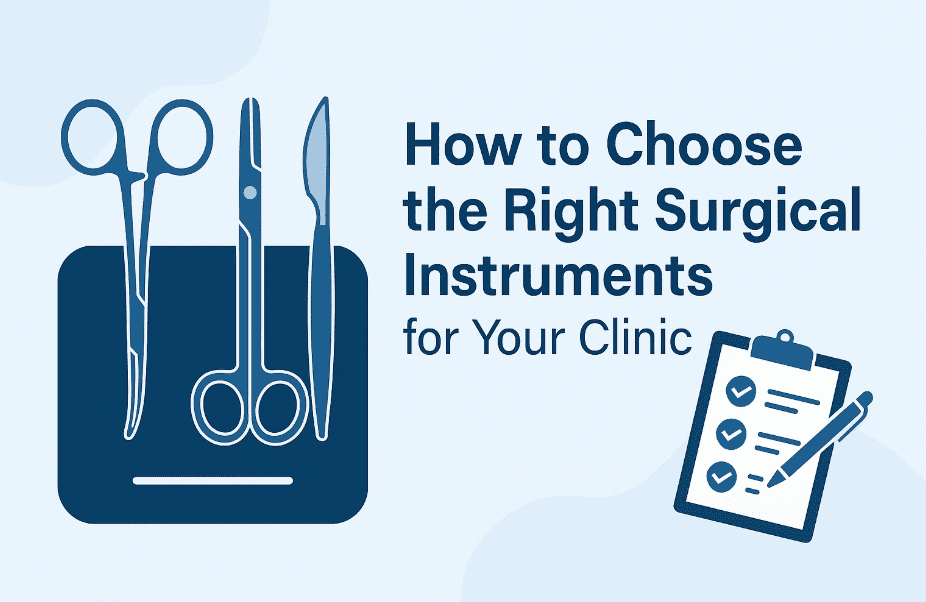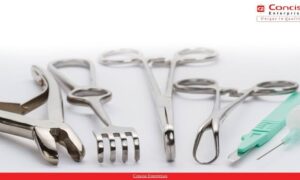When it comes to delivering exceptional patient care, precision and reliability are non-negotiable. Every successful procedure depends not only on the skill of the healthcare professional but also on the quality of the surgical instruments they use. Choosing the right instruments for your clinic is an investment in patient safety, operational efficiency, and long-term success.
This guide will assist you in understanding the most crucial factors to consider when selecting surgical instruments, including the supplier’s reputation, design, and material. In this manner, you can make wise and economical decisions for your medical practice.
Understand Your Clinic’s Specialization and Needs
It’s critical to understand your clinic’s needs before purchasing surgical instruments. Every medical specialty has a variety of instruments designed to perform particular tasks precisely and carefully.
For example:
- ENT (Ear, Nose, and Throat) clinics need delicate forceps, speculums, and suction devices.
- For dental offices, fine-tipped elevators, curettes, and extraction tools are essential.
- Orthopedic clinics require sturdy equipment like drills, bone saws, and retractors.
- General surgery centers use tools like scalpels, scissors, clamps, and retractors on a daily basis.
You can determine which tools you need most by knowing your specialty and the number of procedures you perform. This ensures that your team has the appropriate tools for every situation and prevents you from purchasing unnecessary items.
Prioritize the materials’ quality
The effectiveness, durability, and cleanliness of surgical instruments are directly impacted by the materials that go into their construction.
Common materials used include:
- Stainless Steel (German or Japanese): Offers durability, corrosion resistance, and precision. Ideal for most reusable surgical instruments.
- Titanium: Strength, non-magnetic nature, and light weight make it an excellent material for microsurgical and ophthalmic instruments.
- Tungsten Carbide (TC): This substance prolongs the life and sharpens cutting and gripping instruments.
- Single-Use Polymer Instruments: Ideal for sterile, one-time use in settings with high traffic volumes.
Always go for medical-grade titanium or stainless steel when you need instruments that will be used frequently. Although high-quality materials may initially cost more, they ultimately save money on maintenance and replacement.
Focus on Ergonomic Design and Comfort
Because surgeons and physicians frequently perform lengthy, repetitive tasks, it is crucial that products be made in a way that is comfortable for them. A well-made surgical instrument should be easy to hold and enable precise motion without wearing the user out.
Things to watch out for:
- The distribution of weight is uniform.
- Non-slip handles for secure handling.
- The hinges move smoothly for reliable control.
- Because it disassembles, cleaning and sterilizing is simple.
Better-fitting instruments not only increase the surgeon’s comfort level but also reduce the possibility of errors and muscle strain, increasing the procedure’s overall accuracy.
Ensure Compliance with Medical Standards
International medical and safety standards should be met by all surgical instruments to ensure that patients are safe and that they are all of the same high quality.
Make sure suppliers have the following certifications when you are evaluating them:
- ISO 13485: Certification for quality management in medical device manufacturing.
- CE Marking: Indicates compliance with European health, safety, and environmental requirements.
- FDA Approval (for U.S. clinics): Ensures the instruments meet stringent American healthcare standards.
By following these guidelines, you can be sure that the instruments have undergone extensive testing and satisfy performance, hygienic, and sterilization requirements.
Choose a Reliable Supplier or Manufacturer
Selecting a trustworthy supplier is equally as crucial as selecting the instruments themselves. Quality, reliable performance, and post-purchase assistance are all guaranteed by a good manufacturer.
When examining suppliers, pose the following queries to them:
- Do they only produce medical or surgical instruments?
- Do they have evidence that their products are traceable and safe?
- When something breaks or needs to be fixed, what do they do?
- If you require custom instruments, can they create them?
- After the sale, do they offer assistance and support?
You should pick a reputable company that has been in business for decades and has a track record of dependability if you want to be sure that your instruments can handle contemporary surgical procedures.
Evaluate Cost vs. Value
Although price is always a factor to consider, it shouldn’t be the sole consideration. Cheap instruments frequently sacrifice durability, accuracy, or materials, making replacements more expensive over time.
Instead, consider more than just the cost.
Consider:
- Durability: Can the device withstand repeated sterilizations?
- Performance: When performing delicate tasks, does it provide you with accuracy and control?
- Maintenance Costs: Is it easy to clean, service, and repair?
Purchasing top-notch surgical instruments reduces the possibility of surgical instrument failure, prevents costly downtime, and enhances patient outcomes. Long-term savings result from all of these factors.
Pay attention to the maintenance and sterilization requirements.
Proper sterilization is crucial for patient safety and infection control. Consider how simple it is to clean, sterilize, and disinfect surgical instruments when making your selection.
The following are best practices:
- selecting instruments with gleaming, smooth surfaces that don’t retain dirt.
- avoiding intricate designs that contain tissues or fluids.
- confirming that every tool is safe to use with sterilizing agents and that it can be autoclaved.
In order to reduce glare during procedures, some companies produce instruments with non-reflective finishes that still allow for thorough cleaning.
Instruments that receive routine maintenance—such as lubrication, inspection, and expert servicing—last longer and function like new.
Consider Reusable vs. Disposable Instruments
The decision of whether to use single-use or reusable surgical instruments is another crucial one.
Reusable instruments:
- It was made of titanium or stainless steel.
- saves money over time, but initially costs more.
- Establish stringent guidelines for sterilization and cleaning.
Disposable Instruments:
- To prevent the spread of germs, it is best to use it only once.
- Less money up front, but expenses continue to mount.
- helpful in crowded areas or during emergencies.
For routine procedures, many clinics use reusable tools; for minor or high-risk cases, they use disposable ones. This equilibrium ensures that expenses and patient safety are considered.
Request product demos or samples.
Before making a significant purchase, always request product samples or demonstrations. This enables your surgical team to test the instruments for accuracy, comfort, and utility.
Throughout the assessment, keep the following in mind:
- Keep your balance and hold on tight.
- Hinges and joints glide smoothly.
- adjusting the jaws or blades.
- The quality of the construction and finish.
You can learn a lot about the instrument’s construction and suitability for your needs from a brief hands-on test.
Make Long-Term Support and Replacement Plans
All kinds of instruments deteriorate with time. Choose vendors who can replace, sharpen, and repair items. With a comprehensive support plan, your clinic will always operate at its peak efficiency and with the least amount of downtime.
Look for:
- Spare parts are available.
- Expert programs for repairing or restoring items.
- long-term replacement guarantees or warranties.
You can always get new models, technological advancements, and professional technical support if you build a long-term relationship with your supplier.
Wrapping up
Selecting the appropriate surgical instruments for your clinic involves more than just purchasing equipment. It also involves making investments in performance, accuracy, and patient confidence.
By focusing on the ergonomic design, compliance, supplier dependability, and material quality, you can ensure a safe and efficient clinic. Remember that the most crucial component of any procedure is the surgical instruments. Their dependability impacts patient outcomes, team performance, and your reputation.
Spend time researching, testing, and making informed decisions because your patients deserve nothing less than the best.



































